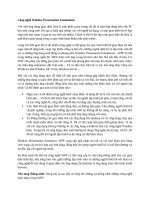princ ch33 presentation
Bạn đang xem bản rút gọn của tài liệu. Xem và tải ngay bản đầy đủ của tài liệu tại đây (1.98 MB, 58 trang )
CHAPTE
R
33
Aggregate Demand and
Aggregate Supply
Economics
N. Gregory
PRINCIPLES OF
Mankiw
Premium PowerPoint Slides
by Ron Cronovich
© 2009 South-Western, a part of Cengage Learning, all rights reserved
In this chapter,
look for the answers to these
questions:
What are economic fluctuations? What are their
characteristics?
How does the model of aggregate demand and
aggregate supply explain economic fluctuations?
Why does the Aggregate-Demand curve slope
downward? What shifts the AD curve?
What is the slope of the Aggregate-Supply curve in
the short run? In the long run?
What shifts the AS curve(s)?
2
Introduction
Over the long run, real GDP grows about
3% per year on average.
In the short run, GDP fluctuates around its trend.
Recessions: periods of falling real incomes
and rising unemployment
Depressions: severe recessions (very rare)
Short-run economic fluctuations are often called
business cycles.
AGGREGATE DEMAND AND AGGREGATE SUPPLY
3
Three Facts About Economic
Fluctuations
FACT
FACT 1:
1: Economic
Economic fluctuations
fluctuations are
are
irregular
irregular and
and unpredictable.
unpredictable.
U.S.
U.S. real
real GDP,
GDP,
billions
billions of
of 2000
2000 dollars
dollars
The
The shaded
shaded
bars
bars are
are
recessions
recessions
4
Three Facts About Economic
Fluctuations
FACT
FACT 2:
2: Most
Most macroeconomic
macroeconomic
quantities
quantities fluctuate
fluctuate together.
together.
Investment
Investment spending,
spending,
billions
billions of
of 2000
2000 dollars
dollars
5
Three Facts About Economic
Fluctuations
FACT
FACT 3:
3: As
As output
output falls,
falls,
unemployment
unemployment rises.
rises.
Unemployment
Unemployment rate,
rate,
percent
percent of
of labor
labor force
force
6
Introduction, continued
Explaining these fluctuations is difficult, and the
theory of economic fluctuations is controversial.
Most economists use the model of
aggregate demand and aggregate supply
to study fluctuations.
This model differs from the classical economic
theories economists use to explain the long run.
AGGREGATE DEMAND AND AGGREGATE SUPPLY
7
Classical Economics—A Recap
The previous chapters are based on the ideas of
classical economics, especially:
The Classical Dichotomy, the separation of
variables into two groups:
Real – quantities, relative prices
Nominal – measured in terms of money
The neutrality of money:
Changes in the money supply affect nominal but
not real variables.
AGGREGATE DEMAND AND AGGREGATE SUPPLY
8
Classical Economics—A Recap
Most economists believe classical theory
describes the world in the long run,
but not the short run.
In the short run, changes in nominal variables
(like the money supply or P ) can affect
real variables (like Y or the u-rate).
To study the short run, we use a new model.
AGGREGATE DEMAND AND AGGREGATE SUPPLY
9
The Model of Aggregate Demand
and Aggregate Supply
P
The price
level
The model
determines the
eq’m price level
and eq’m output
(real GDP).
SRAS
P1
“Aggregate
Demand”
“Short-Run
Aggregate
Supply”
AD
Y1
Y
Real GDP, the
quantity of output
AGGREGATE DEMAND AND AGGREGATE SUPPLY
10
The Aggregate-Demand (AD)
Curve
P
The AD curve
shows the
quantity of
all g&s
demanded
in the economy
at any given
price level.
P2
P1
AD
Y2
Y1
AGGREGATE DEMAND AND AGGREGATE SUPPLY
Y
11
Why the AD Curve Slopes
Downward
P
Y = C + I + G + NX
Assume G fixed
by govt policy.
To understand
the slope of AD,
must determine
how a change in P
affects C, I, and NX.
P2
P1
AD
Y2
Y1
AGGREGATE DEMAND AND AGGREGATE SUPPLY
Y
12
The Wealth Effect (P and C )
Suppose P rises.
The dollars people hold buy fewer g&s,
so real wealth is lower.
People feel poorer.
Result: C falls.
AGGREGATE DEMAND AND AGGREGATE SUPPLY
13
The Interest-Rate Effect (P
and I )
Suppose P rises.
Buying g&s requires more dollars.
To get these dollars, people sell bonds or other
assets.
This drives up interest rates.
Result: I falls.
(Recall, I depends negatively on interest rates.)
AGGREGATE DEMAND AND AGGREGATE SUPPLY
14
The Exchange-Rate Effect (P and
NX )
Suppose P rises.
U.S. interest rates rise (the interest-rate effect).
Foreign investors desire more U.S. bonds.
Higher demand for $ in foreign exchange market.
U.S. exchange rate appreciates.
U.S. exports more expensive to people abroad,
imports cheaper to U.S. residents.
Result: NX falls.
AGGREGATE DEMAND AND AGGREGATE SUPPLY
15
The Slope of the AD Curve:
Summary
An increase in P
reduces the quantity
of g&s demanded
because:
P
P2
the wealth effect
(C falls)
the interest-rate
P1
AD
effect (I falls)
the exchange-rate
effect (NX falls)
Y2
Y1
AGGREGATE DEMAND AND AGGREGATE SUPPLY
Y
16
Why the AD Curve Might Shift
Any event that changes
C, I, G, or NX
– except a change in P –
will shift the AD curve.
P
P1
Example:
A stock market boom
makes households feel
wealthier, C rises,
the AD curve shifts right.
AD1
Y1
Y2
AGGREGATE DEMAND AND AGGREGATE SUPPLY
AD2
Y
17
Why the AD Curve Might Shift
Changes in C
Stock market boom/crash
Preferences re: consumption/saving tradeoff
Tax hikes/cuts
Changes in I
Firms buy new computers, equipment, factories
Expectations, optimism/pessimism
Interest rates, monetary policy
Investment Tax Credit or other tax incentives
AGGREGATE DEMAND AND AGGREGATE SUPPLY
18
Why the AD Curve Might Shift
Changes in G
Federal spending, e.g., defense
State & local spending, e.g., roads, schools
Changes in NX
Booms/recessions in countries that buy our
exports.
Appreciation/depreciation resulting from
international speculation in foreign exchange
market
AGGREGATE DEMAND AND AGGREGATE SUPPLY
19
ACTIVE LEARNING 1
The Aggregate-Demand curve
What happens to the AD curve in each of the
following scenarios?
A. A ten-year-old investment tax credit expires.
B. The U.S. exchange rate falls.
C. A fall in prices increases the real value of
consumers’ wealth.
D. State governments replace their sales taxes
with new taxes on interest, dividends, and
capital gains.
20
ACTIVE LEARNING 1
Answers
A. A ten-year-old investment tax credit expires.
I falls, AD curve shifts left.
B. The U.S. exchange rate falls.
NX rises, AD curve shifts right.
C. A fall in prices increases the real value of
consumers’ wealth.
Move down along AD curve (wealth-effect).
D. State governments replace sales taxes with new
taxes on interest, dividends, and capital gains.
C rises, AD shifts right.
21
The Aggregate-Supply (AS)
Curves
The AS curve shows
the total quantity of
g&s firms produce
and sell at any given
price level.
P
LRAS
SRAS
AS is:
upward-sloping
in short run
vertical in
Y
long run
AGGREGATE DEMAND AND AGGREGATE SUPPLY
22
The Long-Run Aggregate-Supply Curve
(LRAS)
The natural rate of
output (YN) is the
amount of output
the economy produces
when unemployment
is at its natural rate.
YN is also called
potential output
or
full-employment
output.
P
LRAS
YN
AGGREGATE DEMAND AND AGGREGATE SUPPLY
Y
23
Why LRAS Is Vertical
YN determined by the
P
economy’s stocks of
labor, capital, and
natural resources,
P2
and on the level of
technology.
An increase in P
does not affect
any of these,
so it does not
affect YN.
LRAS
P1
YN
Y
(Classical dichotomy)
AGGREGATE DEMAND AND AGGREGATE SUPPLY
24
Why the LRAS Curve Might Shift
Any event that
changes any of the
determinants of YN
will shift LRAS.
P
LRAS1 LRAS2
Example:
Immigration
increases L,
causing YN to rise.
YN
Y’N
AGGREGATE DEMAND AND AGGREGATE SUPPLY
Y
25









